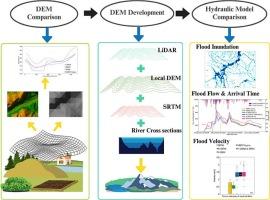Enhancing 2D hydrodynamic flood model predictions in data-scarce regions through integration of multiple terrain datasets
IF 5.9
1区 地球科学
Q1 ENGINEERING, CIVIL
引用次数: 0
Abstract
Topography highly influences hydraulic model predictions. High-resolution Digital Elevation Models (DEM) are currently used in 2D flood modeling studies to create relatively more accurate flood inundation maps. However, the availability of high-resolution datasets, such as Light Detection And Ranging (LiDAR), remains limited due to cost constraints. Thus, low-resolution global datasets are utilized in data-scarce regions. Merging high and low-resolution terrain datasets will be an alternative approach to improve flood models, and comprehensive analysis of such merged DEMs is lacking. Thus, a new DEM (V-DEM) is developed in this study by incorporating available LiDAR, SRTM, local DEM, and river cross-sectional data. 2D unsteady hydrodynamic model predictions are analyzed using the V-DEM, existing low-resolution global datasets, SRTM and MERIT Hydro, and their modified versions. V-DEM was found to create flood flow predictions with a better Nash–Sutcliffe efficiency, significantly outperforming low-resolution global datasets. In addition, MERIT Hydro showed more than 50% improvement in the Nash–Sutcliffe efficiency over SRTM in flow discharge predictions. There is a 110% improvement in the Nash–Sutcliffe efficiency for hydrologically corrected SRTMs over the original SRTM. When SRTM is merged with LiDAR and hydrologically corrected, the predictions also showed an improvement of 146% over the original SRTM. Moreover, this study highlights that the vertical accuracy of terrain datasets has a more significant effect on the flood model predictions than the horizontal resolution, especially in the high and low-gradient regions of the study area. Overall, this study would benefit flood modelers in developing accurate DEMs, especially in the unavailability of high-resolution data for the entire study area.

通过整合多个地形数据集,增强数据稀缺地区二维水动力洪水模型预测
地形高度影响水力模型预测。高分辨率数字高程模型(DEM)目前用于二维洪水建模研究,以创建相对更精确的洪水淹没图。然而,由于成本限制,诸如光探测和测距(LiDAR)等高分辨率数据集的可用性仍然有限。因此,低分辨率的全球数据集被用于数据稀缺地区。合并高低分辨率地形数据集将是改进洪水模型的另一种方法,但缺乏对合并后的dem的综合分析。因此,本研究结合现有LiDAR、SRTM、本地DEM和河流断面数据,开发了一个新的DEM (V-DEM)。利用V-DEM、现有的低分辨率全球数据集、SRTM和MERIT Hydro及其修正版本,分析了二维非定常水动力模型的预测结果。研究发现,V-DEM能够以更好的Nash-Sutcliffe效率创建洪水流量预测,显著优于低分辨率的全球数据集。此外,MERIT Hydro在流量预测方面比SRTM提高了50%以上的Nash-Sutcliffe效率。与原始SRTM相比,经水文校正的SRTM的Nash-Sutcliffe效率提高了110%。当SRTM与LiDAR合并并进行水文校正时,预测结果也比原始SRTM提高了146%。此外,研究还强调了地形数据集的垂直精度对洪水模式预测的影响比水平分辨率更显著,特别是在研究区高、低梯度区域。总的来说,这项研究将有利于洪水建模者开发准确的dem,特别是在整个研究区域无法获得高分辨率数据的情况下。
本文章由计算机程序翻译,如有差异,请以英文原文为准。
求助全文
约1分钟内获得全文
求助全文
来源期刊

Journal of Hydrology
地学-地球科学综合
CiteScore
11.00
自引率
12.50%
发文量
1309
审稿时长
7.5 months
期刊介绍:
The Journal of Hydrology publishes original research papers and comprehensive reviews in all the subfields of the hydrological sciences including water based management and policy issues that impact on economics and society. These comprise, but are not limited to the physical, chemical, biogeochemical, stochastic and systems aspects of surface and groundwater hydrology, hydrometeorology and hydrogeology. Relevant topics incorporating the insights and methodologies of disciplines such as climatology, water resource systems, hydraulics, agrohydrology, geomorphology, soil science, instrumentation and remote sensing, civil and environmental engineering are included. Social science perspectives on hydrological problems such as resource and ecological economics, environmental sociology, psychology and behavioural science, management and policy analysis are also invited. Multi-and interdisciplinary analyses of hydrological problems are within scope. The science published in the Journal of Hydrology is relevant to catchment scales rather than exclusively to a local scale or site.
 求助内容:
求助内容: 应助结果提醒方式:
应助结果提醒方式:


